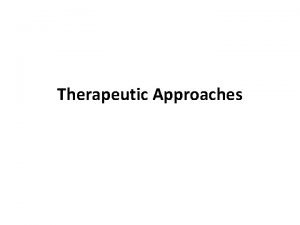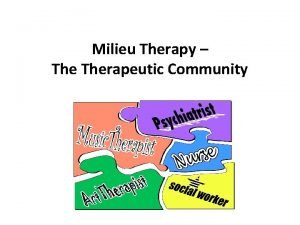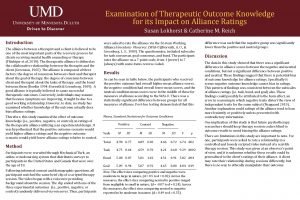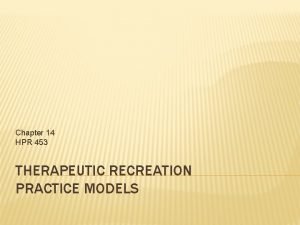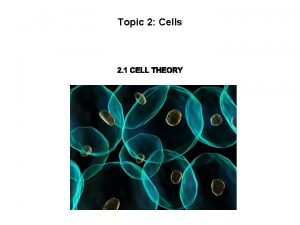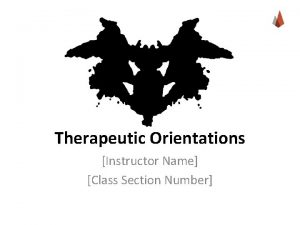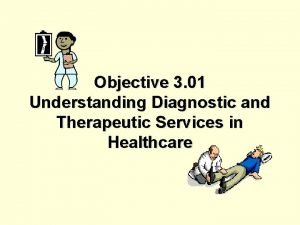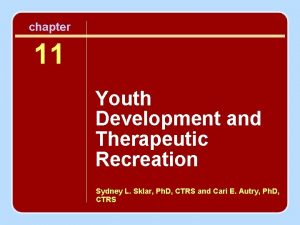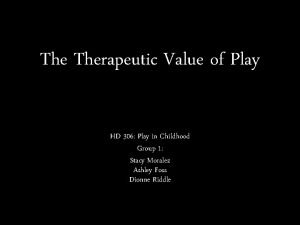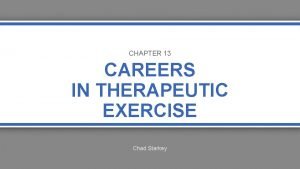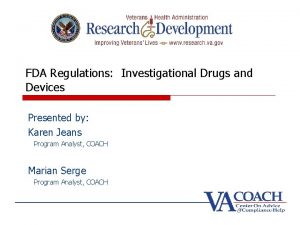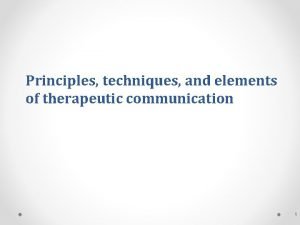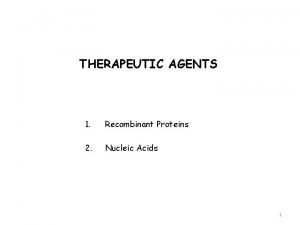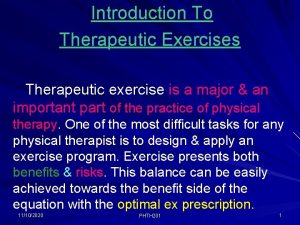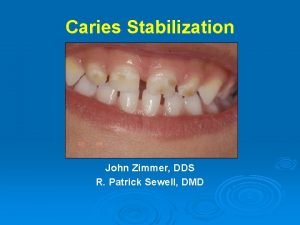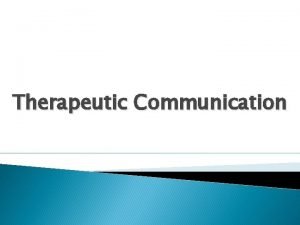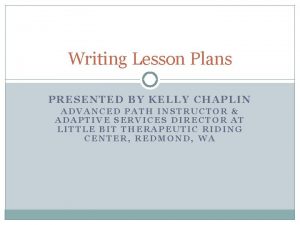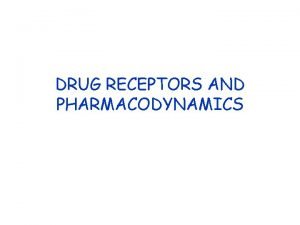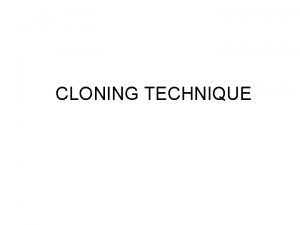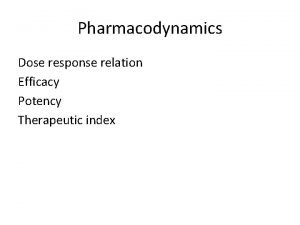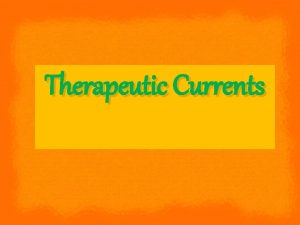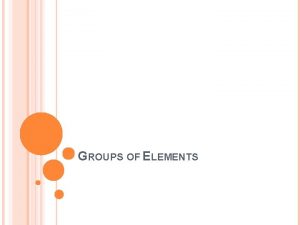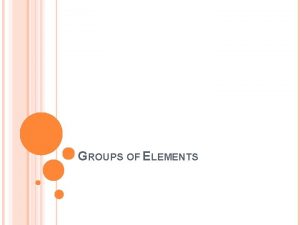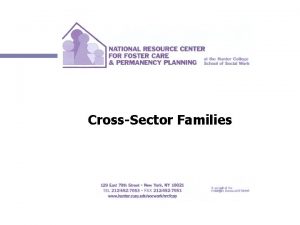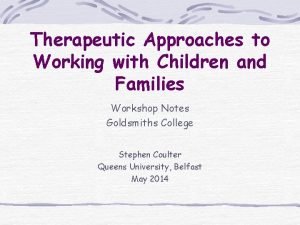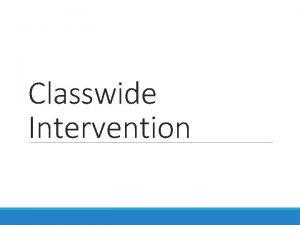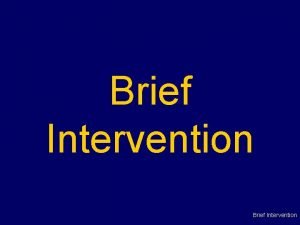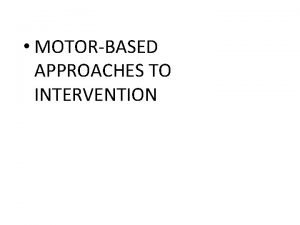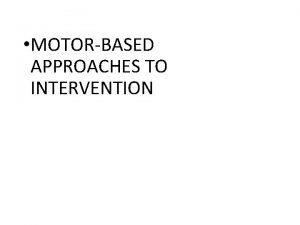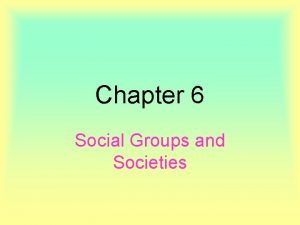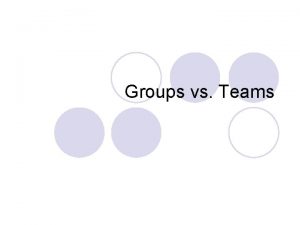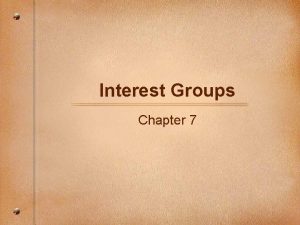Therapeutic Approaches Therapeutic Groups Intervention with Families Mileu


















































- Slides: 50

Therapeutic Approaches

• Therapeutic Groups • Intervention with Families • Mileu Therapy • Relaxation Therapy • Assertiveness Therapy • Promoting Self-Esteem • Behavioral Therapy • Cognitive Therapy • Electroconvulsive Therapy • Complementary Therapy • Client Education

Functions of a Group • • Socialization. Support. Task completion. Camaraderie. Informational. Normative. Empowerment. Governance.

Types of Groups • Task groups. This is a group formed to accomplish a specific outcome. • Teaching groups. The focus is to convey knowledge and information to a number of individuals. • Supportive/therapeutic groups. The primary concern is to prevent possible future upsets by teaching the participants effective ways of dealing with emotional stress arising from situational or developmental crises. • Therapeutic groups vs. group therapy – Group therapy has a sound theoretical base, and leaders generally have advanced degrees in psychology, social work, nursing, or medicine. – Therapeutic groups are based to a lesser extent on theory. Focus is on group relations, interactions between group members, and the consideration of a selected issue. – Leaders of both types of groups must be knowledgeable about group process (the way in which group members interact with each other) as well as group content (the topic or issue being discussed in the group).

• Self-help groups – Composed of individuals with a similar problem – Serve to reduce the possibilities of further emotional distress leading to pathology and necessary treatment – May or may not have a professional leader. Run by members, and leadership often rotates from member to member

The Role of the Nurse in Group Therapy • Nurses who work in psychiatry may lead various types of therapeutic groups, such as client education groups, assertiveness training, support groups for clients with similar problems, parent groups, transition to discharge groups, and others. • Guidelines set forth by the American Nurses Association specify that nurses who serve as group psychotherapists should have a minimum of a master’s degree in psychiatric nursing.

Curative Factors of Groups • • • Instillation of hope. Universality. Imparting of information. Altruism. Corrective recapitulation of the primary family group. Development of socializing techniques. Imitative behavior. Interpersonal learning. Group cohesiveness. Catharsis. Existential factors.

Phases of Group Development Initial or Orientation Phase • Leader and members work together to establish rules and goals for the group. • Leader promotes trust and ensures that rules do not interfere with fulfillment of the goals. • Members are superficial and overly polite. Trust has not yet been established. Middle or Working Phase • Productive work toward completion of the task is undertaken. • Leader role diminishes and becomes more one of facilitator. • Trust has been established between the members, and cohesiveness exists. • Conflict is managed by the group members themselves. Final or Termination Phase • A sense of loss, precipitating the grief process, may be experienced by group members. • The leader encourages the group members to discuss these feelings of loss and to reminisce about the accomplishments of the group. • Feelings of abandonment may be experienced by some members. Grief for previous losses may be triggered.

Leadership Styles • Autocratic. • Democratic. • Laissez-faire.

Member Roles • Members play one of three types of roles within a group: – Task roles – serving to complete the task of the group – Maintenance roles – maintaining or enhancing group processes – Individual (personal) roles – fulfilling personal or individual needs

Family Therapy

Family Therapy The family defined: “A family is who they say they are. ” (Wright & Leahy, 2000) Types of Families • • • Biological family of procreation Nuclear family (incorporates one or more members of the extended family) Sole-parent family Stepfamily Communal family Homosexual couple or family

Family Functioning • Boyer and Jeffrey describe six elements on which families are assessed to be either functional or dysfunctional. 1. Communication 2. Self-concept Reinforcement 3. Family Members’ Expectations 4. Handling Differences 5. Family Interactional Patterns 6. Family Climate

• • Nursing Assessment Nursing Diagnosis Nursing Interventions Milieu Therapy – Goals Therapeutic Community

Milieu Therapy – Therapeutic Community • The psychiatric-mental health nurse provides structures, and maintains a therapeutic environment in collaboration with the client and other health care clinicians. ” • Milieu therapy, or therapeutic community, is defined as “a scientific structuring of the environment to effect behavioral changes and to improve the psychological health and functioning of the individual. ”

Basic Assumptions • The health of each individual is to be realized and encouraged to grow. • Every interaction is an opportunity for therapeutic intervention. • The client owns his or her own environment. • Each client owns his or her own behavior. • Peer pressure is a useful and powerful tool. • Inappropriate behaviors are dealt with as they occur. • Restrictions and punishment are to be avoided.

Basic Assumptions • A treatment plan is directed by an interdisciplinary team. • The plan is formulated by the team. • Team members of all disciplines sign the plan and meet weekly to update the plan as needed. • Disciplines may include psychiatry, psychology, nursing, social work, occupational therapy, recreational therapy, art therapy, music therapy, dietetics, and chaplain’s service.

Role of the Nurse • Through use of the nursing process, nurses manage therapeutic environment on a 24 -hour basis. • Nurses have the responsibility for ensuring that the client’s physiological and psychological needs are met. • Nurses are also responsible for – Medication administration – Development of a one-to-one relationship – Setting limits on unacceptable behavior – Client education

Crisis Intervention • Any stressful situation can precipitate a crisis. • Assistance with problem-solving during the crisis period preserves self-esteem and promotes growth with resolution. • Crisis is defined as a sudden event in one’s life that disturbs homeostasis, during which usual coping mechanisms cannot resolve the problem.

Characteristics of a Crisis • – – – Crisis occurs in all individuals at one time or another and is not necessarily equated with psychopathology. Crises are precipitated by specific identifiable events. Crises are personal by nature. Crises are acute, not chronic, and are resolved in one way or another within a brief period. A crisis situation contains the potential for psychological growth or deterioration.

Phases in the Development of a Crisis 1. The individual is exposed to a precipitating stressor. 2. When previous problem-solving techniques do not relieve the stressor, anxiety increases further. 3. All possible resources, both internal and external, are called on to resolve the problem and relieve the discomfort. 4. If resolution has not occurred in previous phases, the tension mounts beyond a further threshold or its burden increases over time to a breaking point. Major disorganization of the individual with drastic results often occurs. Whether individuals experience a crisis in response to a stressful situation depends on three factors: – The individual’s perception of the event – The availability of situational supports – The availability of adequate coping mechanisms

Types of Crises • Dispositional crises – • Crises of anticipated life transitions – • Crises resulting from traumatic stress – • Psychiatric emergencies –

Crisis Intervention • Nurses may be called on to function as crisis helpers in virtually any setting committed to practice of nursing. • Phase 1. Assessment. • Phase 2. Planning of therapeutic intervention • Phase 3. Intervention • Assessment • Evaluation

Relaxation Therapy • Deep breathing exercises • • • Progressive relaxation Modified (or passive) progressive relaxation Meditation Mental imagery Biofeedback Physical exercise

• Nursing intervention • Patient Education

Assertiveness Training • Honesty is basic to assertive behavior and is expressed in a manner that promotes selfrespect and respect for others. • Basic Human Rights

Four Common Response Patterns • • Nonassertive behavior Aggressive behavior. Passive-aggressive behavior.

Techniques that Promote Assertive Behavior • Standing up for one’s basic human rights • Assuming responsibility for own statements • Responding as a “broken record” – persistently repeating in a calm voice what is wanted • Agreeing assertively – assertively accepting negative aspects about oneself; admitting where an error has been made • Inquiring assertively – seeking additional information about critical statements

• Shifting from content to process – changing the focus of the communication from discussing the topic at hand to analyzing what is actually going on in the interaction • Clouding/fogging – concurring with the critic’s argument without becoming defensive and without agreeing to change • Defusing – putting off further discussion with an angry individual until he or she is calmer • Delaying assertively – putting off further discussion with another individual until he or she is calmer • Responding assertively with irony

Nurses Role • Education. Thought-Stopping Techniques

Promoting Self-Esteem • Healthy self-esteem has been described as essential for psychological survival. • An awareness of self is an important differentiating factor between humans and other animals. • Self-concept has been defined as “the cognitive or thinking component of the self, and generally refers to the totality of a complex, organized, and dynamic system of learned beliefs, attitudes, and opinions that each person holds to be true about his or her personal existence. ” Self-concept consists of the following three components: The physical self, or body image, personal identity and Self-esteem •

Boundaries • Types of physical boundaries include physical closeness, touching, sexual behavior, eye contact, privacy, and pollution. • Touching someone who does not want to be touched is an example of an invasion of a physical boundary. • Types of psychological boundaries include beliefs, feelings, choices, needs, time alone, interests, confidences, individual differences, and spirituality. • Being criticized for doing something differently from others is an example of an invasion of a psychological boundary.

• Boundary pliancy – Boundaries can be rigid, flexible, or enmeshed – Rigid boundaries occur when people have a very narrow perspective on life. They perceive that things must be one way and refuse to change for any reason. – Flexible boundaries occur when people are able to let go of their boundaries as appropriate. Healthy boundaries are flexible. • Enmeshed boundaries occur when two people’s boundaries are so blended together that neither can be sure where one stops and the other begins. An individual with an enmeshed boundary is unable to differentiate his or her wants and needs from those of the other person.

The Nursing Process

Behavior Therapy • A behavior is considered to be maladaptive when it: Is age-inappropriate – Interferes with adaptive functioning – Is misunderstood by others in terms of cultural inappropriateness • The behavioral approach to therapy is that people have become what they are through learning processes or through the interaction of the environment with their genetic endowment. • The basic assumption is that problematic behaviors occur when there has been inadequate learning and therefore can be corrected through the provision of appropriate learning experiences.

• Classical Conditioning • Operant Conditioning

Techniques for Modifying Client Behavior • • • Shaping. Modeling. Premack principle. Extinction. Contingency contracting. Token economy. Time out. Reciprocal inhibition. Overt sensitization. • Covert sensitization. • Systematic desensitization. • Flooding.

Role of the Nurse

Cognitive Therapy • The foundation on which cognitive therapy is established can be identified by the statement, “Men are disturbed not by things but by the views which they take of them. ”

Indications for Cognitive Therapy • Depression • Panic disorder • Generalized anxiety disorder • Social phobia • Obsessive-compulsive disorder • Posttraumatic stress disorder • • Substance abuse Personality disorders Schizophrenia Couple’s problems Bipolar disorder Hypochondriasis Somatoform disorder Eating disorders

• Automatic thoughts – thoughts that occur rapidly in response to a situation and without rational analysis; sometimes called cognitive errors • Some examples are: – – – – Arbitrary inference Overgeneralization Dichotomous thinking Selective abstraction Magnification Minimization Catastrophic thinking Personalization

Basic Concepts • “The general thrust of cognitive therapy is that emotional responses are largely dependent on cognitive appraisals of the significance of environmental cues. ” (Wright, Beck, & Thase, 2003)

Electroconvulsive Therapy • ECT is the induction of a grand mal (generalized) seizure through the application of electrical current to the brain. • Stimulus is applied through electrodes placed bilaterally in the frontotemporal region or unilaterally on the same side as the dominant hand. • Dose of stimulation is based on the client’s seizure threshold, which is highly variable among individuals. • The duration of the seizure should be at least 25 seconds. • Usually administered every other day, for three times per week; most clients need 6 to 12 treatments.

• • • Indications Contraindications Risks Associated with ECT Role of the Nurse

Complementary Therapies • The connection between mind and body is well recognized. • Traditional medicine practiced in the United States is based on scientific methodology and is known as allopathic medicine. • Practices that differ from the usual traditional practices are known as alternative medicine.

• The Office of Alternative Medicine was established by the National Institutes of Health in 1991 to study nontraditional therapies and to evaluate their usefulness and effectiveness. The name has been changed to the National Center for Complementary and Alternative Medicine. • Increasing numbers of third-party payers are bowing to public pressure and including alternative therapies in their coverage. • Some clinicians view these therapies not as alternatives but as complementary therapies in partnership with traditional medicine

• Complementary medicine is viewed as holistic health care, which deals not only with the physical perspective but also with the emotional and spiritual components of the individual. • Most complementary therapies are not founded on scientific principles, but they have been shown to be effective in the treatment of certain disorders and merit further examination as a viable component of holistic health care.

Types of Complementary Therapies • Herbal Medicine • Acupressure and Acupuncture • Diet and Nutrition • Chiropractic Medicine • Therapeutic Touch • Massage • Yoga • Pet Therapy • • • Aromatherapy Hypnosis Meditation Guided imaging others

Client Education • Client education has been defined as “the process of influencing behavior, producing the changes in knowledge, attitudes, and skills necessary to maintain or improve health. It is a holistic process with the goal of changing a patient’s behavior to benefit his or health status. ” (Rankin, Stallings, & London, 2005) • Standard Ve of the ANA Standards of Psychiatric-Mental Health Nursing Practice pertains to “Health Teaching. ” • Health teaching is required by the nurse practice acts and the Joint Commission on Accreditation of Healthcare Organizations (JCAHO).

Nursing Assessment Nursing Diagnosis Outcome Identification Planning/Implementati on • Evaluation • Documentation of Client Education • •
 Mileu therapy
Mileu therapy Mileu dex
Mileu dex Role of nurse in milieu therapy
Role of nurse in milieu therapy Big families vs small families
Big families vs small families How are ethnic groups and religious groups related
How are ethnic groups and religious groups related Amina
Amina Therapeutic equipments
Therapeutic equipments Therapeutic index
Therapeutic index History of therapeutic recreation
History of therapeutic recreation 5 healthcare pathways
5 healthcare pathways Physical incompatibility definition
Physical incompatibility definition Therapeutic outcome study
Therapeutic outcome study Therapeutic recreation outcome model
Therapeutic recreation outcome model Roger verbeeck
Roger verbeeck Therapeutic objectives meaning
Therapeutic objectives meaning Therapeutic story writing starters
Therapeutic story writing starters Outline one therapeutic use of stem cells
Outline one therapeutic use of stem cells Therapeutic services pathway
Therapeutic services pathway Therapeutic orientations
Therapeutic orientations Therapeutic index
Therapeutic index Therapeutic window
Therapeutic window Examples of therapeutic services
Examples of therapeutic services Therapeutic recreation program sydney
Therapeutic recreation program sydney Sepacto
Sepacto Therapeutic drift
Therapeutic drift Therapeutic exercise careers
Therapeutic exercise careers Therapeutic class and pharmacologic class
Therapeutic class and pharmacologic class What is therapeutic equivalence?
What is therapeutic equivalence? Toxicology
Toxicology Jambura re jambura
Jambura re jambura Therapeutic window
Therapeutic window What is a fluid diet
What is a fluid diet Elements of therapeutic communication
Elements of therapeutic communication Therapeutic window
Therapeutic window Therapeutic feeding center adalah
Therapeutic feeding center adalah Therapeutic optimism
Therapeutic optimism Why is a high therapeutic index better
Why is a high therapeutic index better Therapeutic exercise definition
Therapeutic exercise definition Classification of therapeutic exercise
Classification of therapeutic exercise Therapeutic thinking angela wadham
Therapeutic thinking angela wadham Caries stabilization
Caries stabilization What is non therapeutic communication
What is non therapeutic communication Introduction of therapeutic communication
Introduction of therapeutic communication Kelly chaplin
Kelly chaplin Pharmacodynamics
Pharmacodynamics History of cloning
History of cloning Therapeutic index
Therapeutic index Faradic current
Faradic current Intentional relationship model
Intentional relationship model Therapeutic communication techniques
Therapeutic communication techniques Principles of therapeutic exercise
Principles of therapeutic exercise
